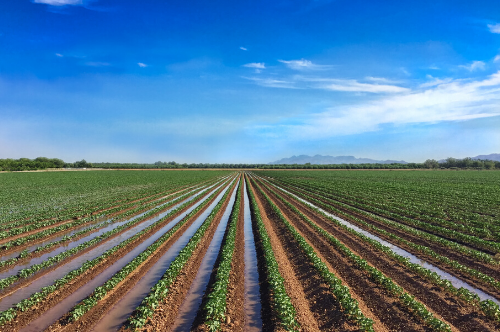Last month, we published an article about sustainable cotton and advancements being made by the cotton industry as a whole. Now we’d like to delve more deeply into a sub-topic that deserves a whole article of its own: sustainable cotton farming. The cotton farming industry has experienced huge success over the last several decades with regard to sustainability, use of resources, and technology.
Let’s take a look at the major areas being targeted in the name of environmental stewardship.
Water Consumption
Advancements in precision agriculture have led to a 75 percent improvement in cotton farmers’ water efficiency over the last two decades. Precision agriculture, which is sometimes called “satellite farming” or “site-specific crop management,” is the practice of observing, measuring, and responding to inter- and intra-field variability in crops. In other words, it means keeping an eye on the various needs of different parts of the crop, and tailoring solutions to each part individually. The goal of precision agriculture is to maximize crop returns while minimizing the amount of resources (like soil and water) used.
Sustainable cotton farmers have experienced a great deal of success with precision agriculture. In large part due to more precise farming practices, irrigation water use has decreased by nearly 80 percent on a per hectare (acre) basis. It has also decreased on an absolute basis by over 50 percent. These days, most U.S. cotton crops survive on rainfall only, as do 50 percent of cotton crops worldwide.
Land Use
The effective and efficient use of agricultural land is one key component to creating a more sustainable future. Thankfully, cotton farmers have put in place a number of practices designed to maximize land use efficiency, including:
- Increasing cotton fiber yields with better genetic varieties and grower management
- Improving soil health through crop rotation, no-till practices, and cover crops
- Adopting improved irrigation scheduling tools, like computer programs and sensors
- Using geospatial technologies to expand precision applications
- Implementing digital technology to provide greater predictive power to farmers
- Educating more farmers on soil health and implementing practices that create a healthy and diverse rhizosphere
- Expanding the use of CRISPR genome editing
- Improving plant breeding techniques and encouraging widespread adoption of improved varieties
As a result of these practices, land use among cotton farmers decreased by almost 50 percent between 1980 and 2015. Cotton Incorporated has also set a goal of increasing land use efficiency by 13 percent over the next decade.
Pesticides
Advancements in pest management and biotechnology mean that today’s cotton farmers can use far fewer pesticides and insecticides than they once had to. In fact, just five grams of pesticides are used on average per kilogram of cotton – much less than other crops. The Boll Weevil Eradication Program, first implemented in the 1970s, is one of the most successful implementations of integrated pest management in world history. Boll weevils once cost American farmers $300 million per year in crop damage; now, they are eradicated in every U.S. cotton growing state except Texas. As a result of this revolutionary initiative, cotton farmers have been able to reduce insecticide applications by 50 percent since the 1980s. And, of those still used, many target specific species – allowing other organisms to survive unharmed and continue contributing to the ecosystem.
We are proud to be a part of the cotton industry, focusing our work on areas like nonwovens for use in hygiene products and baby care. Our industry is leading from the front, as farmers in the USA and around the world are adopting strong measures to help them achieve aggressive goals for sustainability for the next decade and beyond.
